
In Conversation: Sujith Sarang on Bloody Begger
Dec 01 2024
Sujith Sarang is an acclaimed Indian cinematographer celebrated for his visually compelling work in films like Dhuruvangal Pathinaaru, Taxiwaala, Dear Comrade, Mudhal Nee Mudivum Nee, Kanam (Oke Oka Jeevitham in Telugu), and Bloody Beggar. Working predominantly in Tamil, Telugu, and Malayalam cinema, he is an alumnus of the MGR Film and Television Institute. Sujith was honored with the Tamil Nadu State Government Award for Best Student Cinematographer in 2008-2009, marking the beginning of his illustrious career.
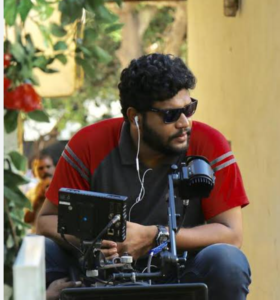
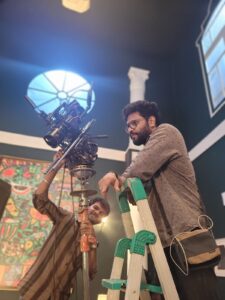
Interview with Sujith Sarang, Cinematographer of Bloody Beggar
When did you first hear about the Bloody Beggar project, and how did you come on board?
I first heard the script in April 2023. It immediately intrigued me because of its unique storytelling potential. I officially joined the prep process in September 2023, where I spent a month collaborating closely with the director M Sivabalan.We explored the script in detail and worked on the visual style together, setting the tone for the project.
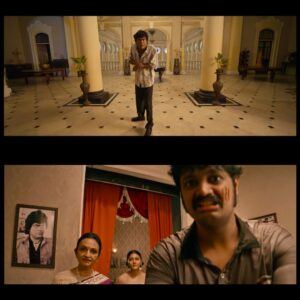
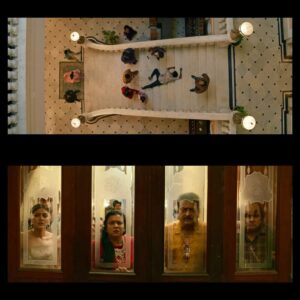
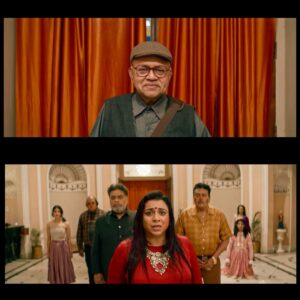

What inspired you to choose a symmetrical framing style for this film?
I’ve been a fan of Edgar Wright and Wes Anderson for years, particularly their use of symmetry and visual precision. While their style doesn’t fit every story, Bloody Beggar felt like the perfect opportunity to explore this approach. When I visited Lalitha Mahal Palace in Mysore, its symmetry and grandeur convinced me that this was the right choice.
How did you balance the contrasting visual elements of the slum and palace settings?
The contrast was deliberate and thematic. In the slum sequences, I desaturated greens and added a brownish tone to convey the protagonist’s lifeless and oppressed existence. In contrast, the palace sequences were vibrant, with saturated greens and warm colors, symbolizing his dream coming to life. Center framing was a unifying technique across both settings to maintain a consistent visual grammar.
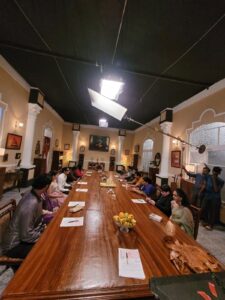
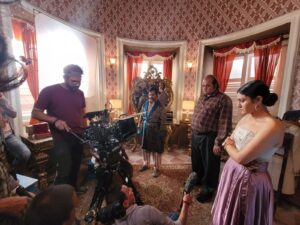
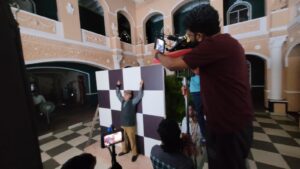
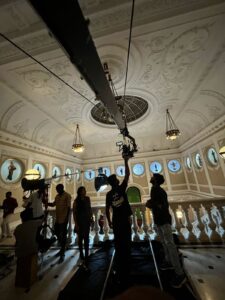
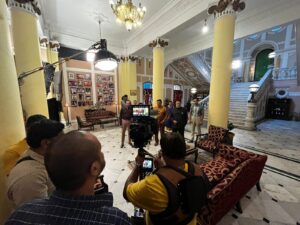
What were the challenges of filming at Lalitha Mahal Palace?
Shooting at the palace came with restrictions. As a tourist destination and resort, we were allowed to shoot only between 9 AM and 9 PM. Night interiors were particularly challenging. To simulate nighttime, we used massive skimmers and black cloth to block natural light, sometimes covering spaces as large as 40×40 feet.
Were additional sets built for the palace scenes?
Yes. While the main lobby, a few corridors, and some rooms were shot at the palace, other locations, like the garage, dining room, aquarium room, and climax hunting room, were recreated as sets at Manimahal in Chennai. This gave us more creative control.
Where were the slum portions shot?
The slum scenes were filmed in Tirisulam near Meenambakkam. The location offered the rawness and texture we needed to authentically portray that part of the protagonist’s journey.
What camera and lighting equipment did you use for the film?
We used the Red Ranger Gemini camera, taking advantage of its exceptional low-light performance. Most shots were at ISOs between 2500 and 3200. For lighting, we relied on LED lights for interiors, which were easy to rig and could be controlled via mobile apps. For exteriors, we used M-series 6K PAR lights.
What focal lengths and lenses did you prefer for this project?
My favorite focal lengths were 32mm and 50mm in the anamorphic format, as they beautifully captured the emotional core of the story. I also used a 12mm Laowa spherical lens for some wide shots to create exaggerated perspectives, adding drama to key scenes. The primary lenses were Atlas Orion anamorphic lenses, which added depth and a unique cinematic quality
How did you approach the color palette for costumes and grading?
I wanted to avoid a monotonous palette. Instead, I explored eccentric and offbeat colors, blending them during grading. Warm lighting tied the palette together. My goal was to achieve 80% of the desired look during the shoot itself, leaving only the final tweaks for DI. Our colorist, Shanmuga Pandian, did an excellent job bringing everything together in DaVinci Resolve.
How did you use anamorphic lenses to enhance the film’s narrative?
Anamorphic lenses not only provided the depth and cinematic feel I wanted but also set the film apart from other symmetrical framing movies, which are typically shot using spherical lenses. It allowed me to transcend the audience into the protagonist’s world, adding layers of visual storytelling.
What is your biggest takeaway from working on Bloody Beggar?
Bloody Beggar was a departure from my usual visual style. It reminded me of the power of experimentation and how embracing limitations can spark creativity. For aspiring cinematographers, my advice is to let the story dictate your style and never shy away from pushing boundaries. This project reinforced my belief in always challenging myself as an artist.
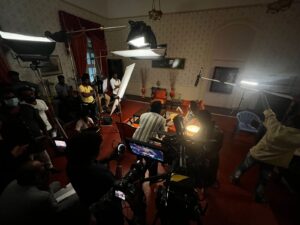
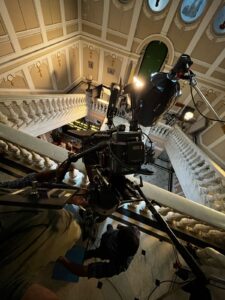
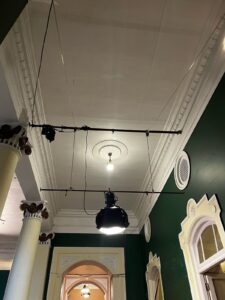
Where can audiences watch Bloody Beggar now?
I’m thrilled to share that Bloody Beggar is currently streaming on OTT platforms. I hope viewers enjoy the visual journey we’ve created.
Article by
CJ Rajkumar
Author/ Cinematographer
